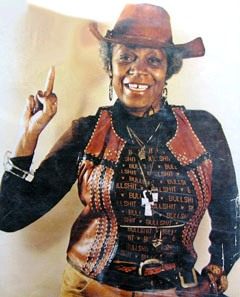The Great Harvard Pee-In of 1973
When fighting for equality meant peeing on the steps.

In 1973, a group of outraged female Harvard activists took to the steps of the school’s historic Lowell Hall and poured out jars of fake urine. The powers that be really should have let them use the bathroom.
The Harvard Pee-In of 1973 was the brainchild of legendary rabble rouser and activist Florynce “Flo” Kennedy. One of the first black women to graduate from Columbia Law School in 1951, Kennedy practiced law prior to devoting her life to activism. Inspired to battled discrimination and inequality, she often fought for feminist and African-American causes, becoming known for her radical, outspoken, and provocative rhetoric and actions.
Kennedy was instantly recognizable by her iconoclastic look, often sporting a cowboy hat, pink sunglasses, and loud outfits while she was out protesting the Miss America pageant or lecturing alongside other feminist luminaries such as Gloria Steinem. In a lengthy obituary in The New York Times (Kennedy passed away in 2000), former New York mayor David Dinkins was quoted as saying, “If you found a cause for the downtrodden of somebody being abused someplace, by God, Flo Kennedy would be there.”

So when some female students at Harvard realized that something had to be done about the lack of female bathrooms, they went straight to Kennedy.

In the early 1970s, Harvard was embroiled in a fight to bring the ratio of female to male students up to 50:50. (the ratio of men-women at Harvard didn’t become even until 2007), and issues of feminism were at the school were on everyone’s minds. But the question of where all of the female students would be able to go to the bathroom at the historically male university wasn’t necessarily everyone’s priority.
And yet, in at least one situation, the lack of available restrooms was actively affecting females’ ability to successfully enroll. In 1973, women took their exams in Lowell Hall, a historic campus building that was equipped with exactly one bathroom. And it was only for dudes.
Women taking part in the lengthy, timed exam process had to leave the building and head across the street to use a women’s bathroom, taking up crucial minutes and actively advantaging male applicants who didn’t have to worry about such inconveniences. This would not stand, and finally one third-year Harvard student reached out to Kennedy for a solution.
Kennedy had been quoted earlier in the year by The Harvard Crimson: “If you had to give the world an enema, you would put it in Harvard Yard. This has got to be the asshole of the world.” When approached, she asked when the next exam was set to take place, and devised a unique protest to bring attention to the issue. According to an extensive first-hand account of the event from 1990, Kennedy dubbed her action “A Protest Pee-In On The Harvard Yard.”
Together with a group of fellow female activists, Kennedy led her protest group around Harvard Yard. They carried signs and banners with slogans like “To pee or not to pee, that is the question,” and “Will the dean let women use his personal toilet?” Most evocatively, many of them also carried jars of bright yellow liquid.
The group had gathered a crowd of onlookers as Kennedy finally took the steps of Lowell Hall and spoke. Kennedy gave a characteristically impassioned speech about the importance of gender equality in bathroom availability, pointing out how the disparity led to women feeling “niggerized” by the exclusion. She highlighted the fact that Harvard was built by men to cater to men, but that women have always been a huge part of the school’s fabric, if not always as students, then as secretaries and other workers. The lack of bathrooms wasn’t just an inconvenience, it was a sign of the institutionalized inequality at the school.

After Kennedy finished speaking and a poem about pay toilets was read, the assembled activists, one after another, took turns pouring the symbolic pee on the steps of Lowell Hall. According to that same 1990 account, one of the onlookers called foul, complaining that she thought they were actually going to urinate on the steps, even offering to do it herself. But at this Kennedy, quieted the crowd, saying, “Let the Dean of Harvard be warned. Unless Lowell Hall gets a room for women so that women taking exams don’t have to hold it in, run across the street or waste time deciding whether to pee or not to pee, next year we will be back doing the real thing.”
It’s unclear whether or not Kennedy’s protest led to any immediate changing of the bathroom rules in Lowell Hall, but according to a 2012 survey of Harvard bathrooms, the campus now has 91 gender non-specific restrooms across residential buildings, classroom buildings, and restrooms available in businesses. The school has come a long way from the days when women had to go on a minor field trip just to relieve themselves, but all of the handy places to urinate that exist today may have never opened their doors without the women who peed on the steps of Lowell Hall.







Follow us on Twitter to get the latest on the world's hidden wonders.
Like us on Facebook to get the latest on the world's hidden wonders.
Follow us on Twitter Like us on Facebook